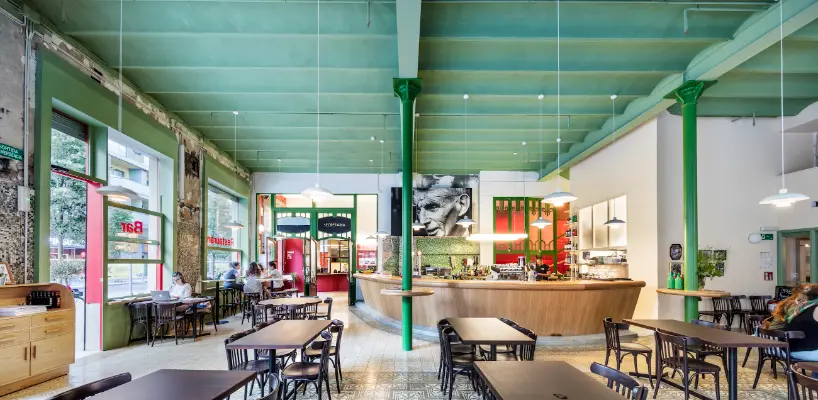Sala Beckett

下载所需积分: 1
Sala Beckett是一个由Flores & Prats设计的文化空间,位于巴塞罗那。建筑师Ricardo Flores和Eva Prats对Pau i Justicia合作社的旧建筑进行了修复,适应新的戏剧用途。这个空间以其非凡的活力和与历史的惊人关系而著称,重新定义了建筑修复的主题。
新的Sala Beckett于2016年11月在Poblenou的Sant Martí区开幕,专注于戏剧、实验和培训。这个创造与交流的场所位于旧和平与正义合作社的总部。建筑师Ricardo Flores和Eva Prats的设计反映了深深植根于历史工业区文化中的丰富记忆,该地区在1992年奥运会前已经经历了重大变化,如今因众多艺术家和创意人才的涌入而变得生机勃勃。
在导演José Sanchis Sinisterra的努力下,Sala Beckett在过去的25年中成长为巴塞罗那文化的中心。新地点将由Toni Casares管理,建筑师Flores & Prats与他一起长期合作,创造一个能够诠释其重要角色并将其重新融入Poblenou生活的空间。为了设计新地点,建筑师Ricardo Flores和Eva Prats花了大量时间了解制作活动和戏剧实验,与Toni Casares及其他将使用新空间的人进行讨论。他们参观了Peter Brook的Bouffes du Nord剧院,并研究了多个案例,使他们能够对主题形成个人而深刻的理解,并在旧建筑中重新诠释,展现出与空间及其历史对话的细致能力。
“我们遇到的破败状态引起了我们的兴趣,不是因为我们想要修复它,而是希望将这份破败向前推进,使其以叠加时期的未完成特征参与到一个新的现实中,这个现实将继续在这个基础上不断更新。……因此,项目的挑战在于将建筑适应其新用途,而不驱逐其幽灵。”建筑师Ricardo Flores和Eva Prats说道。
Flores & Prats的设计源于现有建筑的空间和装饰特性,这是巴塞罗那在工人协会兴起时所承载的城市身份的一部分,展现了其惊人的娱乐空间创造能力。每一个重要元素都经过精心收集,从框架到门、彩色瓷砖、玫瑰窗、砖石结构中的分层以及灰泥工艺。设计过程包括对环境特征的深入研究,通过大量绘图和详细的研究模型进行识别和发展。
“新的Sala Beckett是一个观众进入并呼吸的空间,理解并感受到他们不是工业产品的顾客,而是对话的一部分,是一个能够理解舞台上所呈现内容的人。”Sala Beckett的剧作家和导演Toni Casares说道。
这座建于1920年代的建筑虽然处于废墟状态,但它拥有许多Ricardo Flores和Eva Prats选择保留的特征,从而保留了原建筑的实质痕迹。他们还希望展望未来,将建筑的所有时间和使用的迹象与分层转化为一种装置,以赋予Sala Beckett进行戏剧相关研究的进一步意义。
该建筑位于Carrer de Pere IV和Carrer de Batista的交汇处,位于Poblenou的中心。立面的角落开口使内部进行的活动可见且可接近。大部分位于底层的房间用于公共活动,这与城市结构建立了连续的关系。进入后,访客会发现一个温馨、几乎是家庭式的环境。人们可以在酒吧喝一杯,或在餐厅等候演出开始,或者坐在长椅上,或前往售票处购票。
底层以高空间艺术性和惊人的活力为特征,还有一些不对公众开放的房间,如办公室和表演者的更衣室,通过一个外围走廊与主要表演区相连,使他们能够从不同的点进入舞台,从而适应为200人设计的这个房间中的各种舞台结构。排练室位于一楼,还有一个更大的房间,原为舞厅,可以用作工作坊和第二个表演空间。其他排练室和服务区域位于二楼。
从上方透过天窗洒下的光线为入口区域带来了空间的复杂性,并为整个建筑提供了统一感,轻柔地照亮了底层。在旧合作社的大厅里,这些光线引导公众走向表演区域。
Sala Beckett is a cultural space designed by Flores & Prats in Barcelona. Architects Ricardo Flores and Eva Prats restored the old building of the Pau i Justicia cooperative, adapting it for new theatrical uses. The space is characterized by extraordinary vivacity and a surprising relationship with history which tends to redefine the theme of architectural restoration.
The new Sala Beckett, opened in November 2016 in Poblenou, in the Sant Martí district, is dedicated to theatre, experimentation and training. This place for meeting and creativity found a space in the headquarters of the old Peace and Justice cooperative (Pau i Justicia). The design by architects Ricardo Flores and Eva Prats reflects the dense memories profoundly rooted in the culture of the historical industrial district, which had already undergone significant changes for the 1992 Olympics and has now become vibrant due to the presence of numerous artists and creative talents..
Having grown for 25 years through the commitment of the director José Sanchis Sinisterra, Sala Beckett has been a central place in the culture of Barcelona for some time. The institution will be run in its new location by Toni Casares, together with whom the architects Flores & Prats, winners of the competition announced in 2011, have worked for a long time to create a space capable of interpreting its important role and relaunching it into the life of Poblenou. To come up with a design for the new location the architects Ricardo Flores and Eva Prats spent much time learning about the production activities and theatrical experimentation, discussing it with Toni Casares and the other people that would then make use of the new spaces. They visited Théâtre des Bouffes du Nord by Peter Brook and studied several cases, enabling them to develop a personal and profound awareness of the subject matter which they then reinterpreted inside the old building with their meticulous ability to dialogue with spaces and their histories.
“The ruinous state in which we encountered was of interest, not because we wanted to restore it, but rather to take the ruin forward and make it a participant, with its unfinished character of superimposed periods, in a new reality that would continue to be updated on this foundation. (...) The challenge of the project is therefore to adapt the building to its new use without banishing its ghosts.” said architects Ricardo Flores and Eva Prats.
The design by Flores & Prats stems from the spatial and decorative qualities of the existing building, a part of the identity assumed by the city of Barcelona at a time when the workers’ associations emerged along with their surprising capacity to create space for entertainment. Each significant element has been carefully collected, from the frames to the doors, the polychrome tiles, rose windows, the stratifications present in the masonry fabric and the plasterwork. The design process included an in-depth study of the environmental characteristics, identified and developed through numerous drawings and detailed study models.
“The new Sala Beckett is a space where the audience member enters and breathes, understands, feels that they are not customers for an industrial product, but part of a dialogue, a person who makes sense of what is presented on stage.” said Toni Casares, playwright and director of Sala Beckett.
The building constructed in the 1920s was in ruins, however it had a high number of features that Ricardo Flores and Eva Prats have chosen not only to leave in place, thereby leaving substantial traces of the original building intact. They also wanted to project into the future, turning all the signs and stratifications of time and the uses of the building into a device through which to give further meaning to the drama-related research conducted by Sala Beckett.
The building is located at the intersection of Carrer de Pere IV and Carrer de Batista, in the heart of Poblenou. The corner opening in the façade makes the activities carried out on the inside visible and accessible. Most of the rooms located on the ground floor are used for public activities and this establishes a relationship of continuity with the urban fabric. Immediately after the entrance visitors come upon a welcoming, almost domestic setting. People can get a drink at the bar or sit in the restaurant while waiting for the performance to start, or they can sit on the benches or visit the box office to buy a ticket.
Characterized by high spatial articulation and surprising vivacity, the ground floor also has rooms that are not accessible to the public, such as offices and changing rooms for the performers, connected to the main performance area by a peripheral corridor that allows them to enter the stage from different points and thereby to accommodate the various stage structures planned in this room for 200 people. Rehearsal rooms are located on the first floor along with another larger room, the former ballroom, which can be used both as a workshop and as a second space for performances. Other rehearsal rooms and service areas are found on the second floor.
The light that filters from above through a skylight into the entrance area gives rise to the complexity of the spaces and delivers a sense of unity to the whole building, gently reaching down to the ground floor. Here, in the lobby of the old cooperative, it guides the public towards the performance areas.